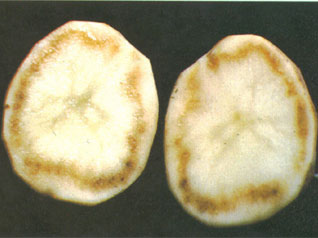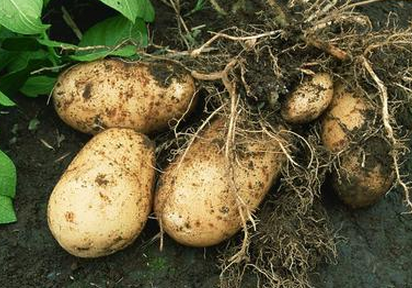Potato ring rot is a common disease, but the symptoms of diseased seed potatoes, especially external symptoms, are not obvious. Infection and storage are prone to infection. There are often four situations in production: 1 rotten seeds during the germination process. 2 no seedlings after sowing. 3 died after emergence. 4 The formation of diseased plants, less potato, small potato pieces, and rotted seed potatoes (in contrast to normal seed potatoes to the late growth stage, the contrast is obvious). The pathogen is a bacterium belonging to the bacterium, which has a short survival period in the soil, mainly overwintering in the potato block, and the transmission route is a diseased seed potato, so the prevention before the broadcast is twice as effective. Precaution: 1. Strict management of seed potatoes (1) The seed potato sales department should remove the diseased potatoes while harvesting from the harvest; strengthen the quarantine when transporting, and strictly prohibit the transfer from the ward. (2) After the tuber is harvested, it should be placed in a ventilated place for 2 to 3 weeks. When the temperature is stable at 0 °C, the seed will be strictly selected before the seedling, and the diseased potato, mechanical damage, insect injury, and Flooded, chilled potato pieces. (3) When storing, choose a place that is sheltered from the wind and the sun is well drained. During storage, ventilation and ventilation are guaranteed. The temperature is kept at 1~3°C, and the relative humidity is about 90%. Check frequently and find that the diseased potato together with the surrounding potato chips are removed in time. 2. Select resistant varieties suitable for local cultivation such as Lu Yin No. 1 (Netherlands No. 7) and Zhengshu No. 4. 3, small whole potato seeding small whole potato strong vitality, good disease resistance, at the same time can avoid cross-infection of ring rot bacteria, but also avoid the healing of the cut surface, the invasion of saprophytic bacteria. In production, it is recommended to use small whole potatoes as seed potatoes. 4, whole potato germination, the current broadcast cut is mainly to avoid long-term contact between the cut surface and the cut surface. Strictly remove the diseased potato before germination; prepare as many cutters as possible before cutting, and cut the knife first with alcohol or flame disinfection; observe the cut surface when cutting the potato, and find that when the vascular bundle turns into milky yellow to dark brown, the diseased potato is first removed. Then change the cutter and soak it in a 50 mg/L copper sulfate solution for more than 10 minutes. 5, the grass ash mixed seed cut surface layered with a layer of grass ash, not only keep the cut surface dry, prevent and cure the bacteria, but also added potassium fertilizer, which is good for drought resistance and cold resistance. 6. Apply 50 mg/kg of copper sulfate poisonous soil to each well at the point of application. Pay attention to the surrounding area. 7. Formulated fertilization, ridge cultivation for organic fertilizer application, nitrogen, phosphorus and potassium are suitable in a ratio of 2.5:7:4.5, phosphate fertilizer is applied with calcium phosphate to supplement calcium; ridge planting to enhance plant resistance Sex. Environmentally friendly lubricants, also known as environmentally acceptable lubricants, must have the following characteristics: first, it has good lubrication performance, can reduce environmental pollution by saving energy; Second, the product itself is harmless to the environment and has little impact; Third, this product can be biodegradable, and can be decomposed into simple CO2 and water, which can be absorbed by the environment without any harm. Imported Bio-Based Lubricant,Bio-Degradable Industrial Lubricant,Renewable Vegetable Raw Materials,Bio-Based Lubricant Xingbang High Molecular Materials Co., Ltd. , https://www.chemicaladditive.com

The US Environmental Protection Agency (EPA) defines environmentally friendly lubricants as ultimately biodegradable, low toxic and non-bioaccumulative.
Potato clever ring rot